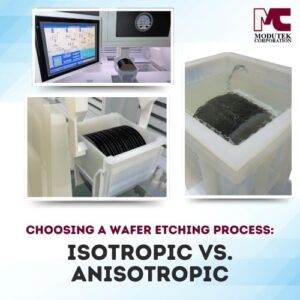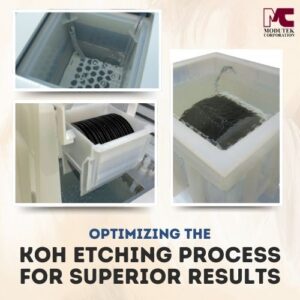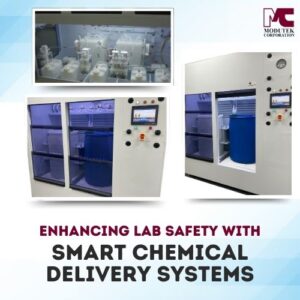![]()
Editor’s Note: This article was originally published in August 2019, and has been updated with additional information and reposted in May 2023.
Silicon wet etching is a crucial process used in the semiconductor industry to form various structures and patterns on silicon substrates. Isotropic and anisotropic wet etching techniques are two types frequently used in the industry, each offering distinct benefits and limitations.
Understanding these etching processes’ differences, equipment, and process parameters is essential to achieving the desired results. In this article, we will cover the fundamentals of isotropic and anisotropic silicon wet etching processes along with the associated equipment used for wet etching, process parameters, and tradeoffs between them.
Isotropic Silicon Wet Etching
Isotropic silicon wet etching is a process in which material is removed uniformly in all directions from a silicon substrate. This method is particularly useful for applications that require smooth surfaces or the removal of material over large areas of the substrate. The most commonly used isotropic etchants include mixtures of hydrofluoric acid (HF) and nitric acid (HNO3), which etch silicon uniformly regardless of its crystallographic orientation (University of Maryland).
The advantages of isotropic etching include its ability to create smooth surfaces, making it ideal for wafer thinning, polishing, and creating microfluidic channels. However, the lack of directionality in the etching process can lead to challenges in forming precise structures with sharp edges. One significant drawback is undercutting, where the etchant removes material beneath the masking layer, causing features to expand beyond their intended dimensions.
In semiconductor applications, isotropic etching is commonly used to create through-holes in silicon wafers, fabricate microlenses for optical applications, and develop thin silicon membranes for pressure sensors. It is also widely employed in manufacturing microelectromechanical systems (MEMS), particularly for applications requiring smooth surface profiles.
Anisotropic Silicon Wet Etching
Anisotropic silicon wet etching is a process that selectively removes material along specific crystallographic planes of the silicon substrate, producing well-defined structures with sharp corners and edges. Unlike isotropic etching, anisotropic etching proceeds at different rates depending on the orientation of the silicon crystal lattice, which allows for precise feature formation.
The most widely used anisotropic etchants include potassium hydroxide (KOH etching) and tetramethylammonium hydroxide (TMAH). These etchants preferentially etch silicon along the (100) and (110) planes while etching much more slowly along the (111) planes, resulting in well-defined features with characteristic angled sidewalls (University of California at Irvine).
Anisotropic etching offers several advantages, including the ability to create precise structures with well-controlled geometries, making it essential for fabricating MEMS devices, microfluidic channels, and deep trenches for high-density capacitors. Additionally, it is commonly used to produce gratings for optical applications where precise feature dimensions are critical.
However, anisotropic etching also has limitations. The etching process can be relatively slow, especially for deep structures, and the etch rate is highly dependent on the orientation of the silicon wafer. Additionally, achieving high aspect ratio features can sometimes lead to mechanical stress, causing bowing or bending in the substrate.
Anisotropic etching is extensively used in semiconductor manufacturing to create intricate microstructures. It is often combined with isotropic etching techniques to form complex three-dimensional structures tailored for specific applications.
More details on isotropic and anisotropic silicon wet etching can be found in the following documentation:
- Silicon Wet Isotropic and Anisotropic Etching, University of Maryland
- Anisotropic Silicon Etch Using KOH, University of California at Irvine
Comparing Isotropic and Anisotropic Silicon Wet Etching Processes
Isotropic and anisotropic silicon wet etching differ in their mechanisms and surface morphologies. While isotropic etching removes material uniformly in all directions, anisotropic etching preferentially removes material along certain crystallographic planes. The tradeoffs between using isotropic and anisotropic etching depend on the specific application.
Etching Mechanisms: Isotropic etching involves removing material in all directions at an equal rate, creating a rounded profile. Meanwhile, anisotropic etching removes material along specific crystallographic planes, producing sharp corners and edges. Anisotropic etchants allow precise control over the etched features, which is useful in creating precise structures.
Etched Surface Morphology: While isotropic etching usually produces a smooth surface, anisotropic etching may produce rough surfaces due to exposed crystallographic planes being exposed. In addition, anisotropic etching can create surface defects like hillocks or pits due to these planes being exposed unevenly.
Tradeoffs of Isotropic and Anisotropic Etching: Selecting isotropic versus anisotropic etching will depend on the application requirements. Isotropic etching is an efficient process for producing uniform etch profiles and quickly removing large volumes of material, making it suitable for silicon wafer thinning and polishing applications. However, due to a lack of directional control during isotropic etching, it may be difficult to create precise structures. Anisotropic etching can create precise structures with distinct corners and edges, making it suitable for MEMS devices and microfluidic channels. However, its selectivity often results in slower etching rates and greater aspect ratios, which requires careful consideration of process parameters and equipment when using this production method.
Wet Etching Process Parameters
Wet etching is a process that relies on a controlled chemical reaction between an etchant and the substrate to achieve the desired etch profile. Controlling the process parameters is key to creating the desired etch conditions, which include etch rate, selectivity, and surface roughness characteristics.
Importance of Controlling Process Parameters: Controlling process parameters is essential to achieve consistent and repeatable wet etching results. Even minor fluctuations in temperature, chemical concentration, or agitation can significantly affect the etch rate, selectivity, and surface roughness. By carefully managing these process parameters, it is possible to achieve the desired etch characteristics and ensure both quality and consistency with the final products.
Commonly Controlled Process Parameters in Wet Etching: There are various process parameters commonly controlled in wet etching, including temperature, agitation, chemical concentration, and pH. Temperature impacts the rate of chemical reaction, which in turn determines the selectivity and uniformity of an etch. Agitation ensures the even distribution of etchant across substrate surfaces, which in turn helps with the uniformity of an etch. In addition, the chemical concentration and pH can alter the rate, selectivity, and surface roughness of substrate surfaces.
Effects of Process Parameters on Etch Rate, Selectivity, and Surface Roughness: Careful control of process parameters can have an enormous impact on etch rate, selectivity, and surface roughness of substrates. Increasing the temperature may increase etch rates but can also decrease selectivity, which results in undercutting or etching unwanted features. Increasing agitation may improve uniformity while at the same time increase surface roughness. By carefully controlling the process parameters, it is possible to achieve the desired etch characteristics while mitigating any undesirable side effects.
Wet Etching Equipment
Silicon wet etching is a standard process used in the semiconductor industry for precisely patterning and shaping silicon substrates. Several types of equipment are needed for silicon wet etching, each offering distinct features and capabilities.
Types of Equipment Used for Silicon Wet Etching: Three primary forms of wet etching equipment used on silicon are manual wet benches, semi-automatic wet benches, and fully automated wet processing systems. Manual benches typically serve low-volume production applications, while semi-automatic and fully automated systems are used for high-volume production environments.
Key Features and Capabilities of Wet Etching Systems: Wet etching systems typically include a chemical tank, temperature control system, wafer carrier, and system for stirring the etchant. Semi-automatic and fully automated systems may include robotic wafer handling, chemical mixing, dispensing systems, and inline metrology equipment for monitoring process parameters. These wet etching systems can also be tailored or explicitly customized to accommodate various substrates and etchants and be designed for specific applications, such as deep silicon etching for MEMS devices.
Factors to Consider When Selecting Silicon Wet Etching Equipment: When choosing wet etching equipment, several factors should be considered, including required etch rate, etch profile, selectivity, and uniformity. Other aspects may include processing substrate type, chemical compatibility of the etchant with the equipment, and the level of automation required by the application. Cost is also a significant consideration, and it could range anywhere between tens of thousands to millions of dollars, depending on system complexity and capabilities.
Modutek’s Equipment Support for Isotropic and Anisotropic Wet Etching Processes
Modutek provides extensive silicon wet etching equipment to support customers using the isotropic and anisotropic wet etching processes. This includes Modutek’s Teflon tanks which come in temperature-controlled and ambient versions. For processes dependent on temperature for controlling etch rate, the tank temperature controllers provide rapid and accurate heating. In addition, concentrations can be maintained by supplementing de-ionized water with custom tank sizes if needed.
Contact Modutek for a free consultation or quote on selecting the right silicon wet etching equipment to support your etching process requirements.




